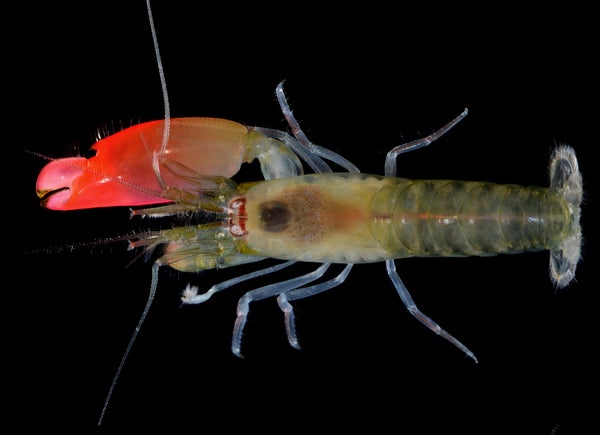This article was published in Scientific American’s former blog network and reflects the views of the author, not necessarily those of Scientific American
Imagine losing your thumb in an accident and being able to regrow it: manufacturing muscle and bone, threading new blood vessels through developing flesh, and regaining grasp in a rudimentary appendage that gradually grows to its former size. Such physiological feats are beyond us but not unfamiliar. Crabs replace lost claws and salamanders grow new tails.
Now, instead of just regeneration, imagine transformation: converting your pinky into a new thumb while growing a new little finger in the missing digit’s spot. Your pinky already has muscle and bone, and it is currently connected to your body’s blood and brain. Repurposing existing tissue replaces the larger, more critical limb faster. Are we imagining the impossible?
There are more things in heaven and earth, to paraphrase Shakespeare, than are dreamt of in our physiology. What for us—even with all our medical knowledge and technology—remains difficult to envision, for many creatures is simply routine, a natural healing process. For powers of transformation that make pinky-to-thumb seem trivial by comparison, consider the snapping shrimp.
On supporting science journalism
If you're enjoying this article, consider supporting our award-winning journalism by subscribing. By purchasing a subscription you are helping to ensure the future of impactful stories about the discoveries and ideas shaping our world today.
Snapping shrimp do not resemble the shrimp you might eat, but rather look like little crayfish with extremely mismatched claws. The smaller pincer is unsurprising in size and simply shaped. It has two nearly straight fingers, like tweezers, with sensory hairs bristling across their surface. Like most crustacean claws, it is multipurpose: it grasps food, digs burrows and performs any task requiring grip.
On (literally) the other hand, the larger claw is nearly half the size of the shrimp’s entire body and its shape is specialized for snapping. When the snapper closes quickly, a plunger on one digit enters a socket on the other and a stream of water shoots out so fast that a bubble forms in its wake and then pops, producing the sound for which the shrimp is named. Snaps onto the body of an opponent can be deadly, snipping off limbs or clipping through carapace. Shrimp wield this weapon to defend shelters and mates and to crack into shells for food. Dropping a snapper when grabbed by a predator might save a shrimp’s life but leaves it defenseless; snapless shrimp are sad and helpless beasts. My colleagues and I have been studying the behavior patterns, neurobiology and mechanics of what happens next.
When the snapping claw is lost, a remarkable process begins. At the next molt three to four weeks later, a tiny pincer appears where the snapper used to sit, and a small, somewhat misshapen snapper emerges from the pincer’s exoskeleton—a lumpy butterfly from a skinny, forked chrysalis. The plunger is petite but produces a faint snap; behavioral function is at least partially restored. The sensory hairs, however, remain pincer-like. Perhaps this new “thumb” still feels like a “pinky”?
After another molt, the sensory hairs will be snapper-like, the plunger a bit larger, the shape more similar to a pristine snapper and the snap more robust. In just a few weeks more, it will be impossible to tell any injury had occurred. The weapon and the tweezers simply switch hands. These are remarkably different appendages, used for completely different behaviors, yet within weeks one converts into the other, changing in shape, size and function, swapping both sensory input and motor control.
Scientific knowledge usually expands gradually. Each experiment or set of observations tests a hypothesis. New hypotheses are then generated in turn, and slowly we trudge toward better understanding. But this common description of the scientific method omits the role of inspiration. The chemist August Kekulé dreamt of a snake eating its tail and awoke realizing that benzene’s molecular structure is a ring—a leap of insight that changed chemistry. In evolutionary biology we speak of “hopeful monsters”: when a mutation causes a profound change, the result may be an organism quite unlike its ancestors that has the potential to propel evolution down unexpected paths. Inspiration is the hopeful monster of science. Who can say how it will come?
Perhaps it will come from the snapping shrimp. We know too little of this animal’s remarkable gift of transformation to predict whether anything we learn from it will ever be useful to medicine. Our pinkies will not soon become thumbs—but we cannot strive for what we cannot imagine, and who would have imagined such digit redevelopment without knowing these physiologically fantastic beasts? Most medical research focuses on a handful of nonhuman species, and with good reason. The advantages of these “model systems” are many.
The depth of understanding we gain from them, however, comes at a cost. They are but a small subset of biological diversity, and they provide an unavoidably limited view of what living things can do. Life’s problems have a multiplicity of solutions; knowing more of them sows the seeds for creative approaches to our own. We need the model systems, but we need our hopeful monsters too.
